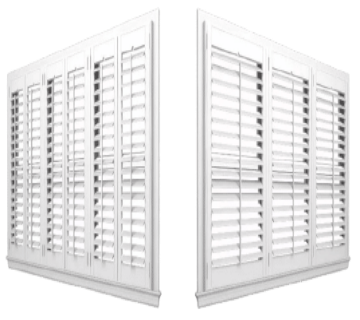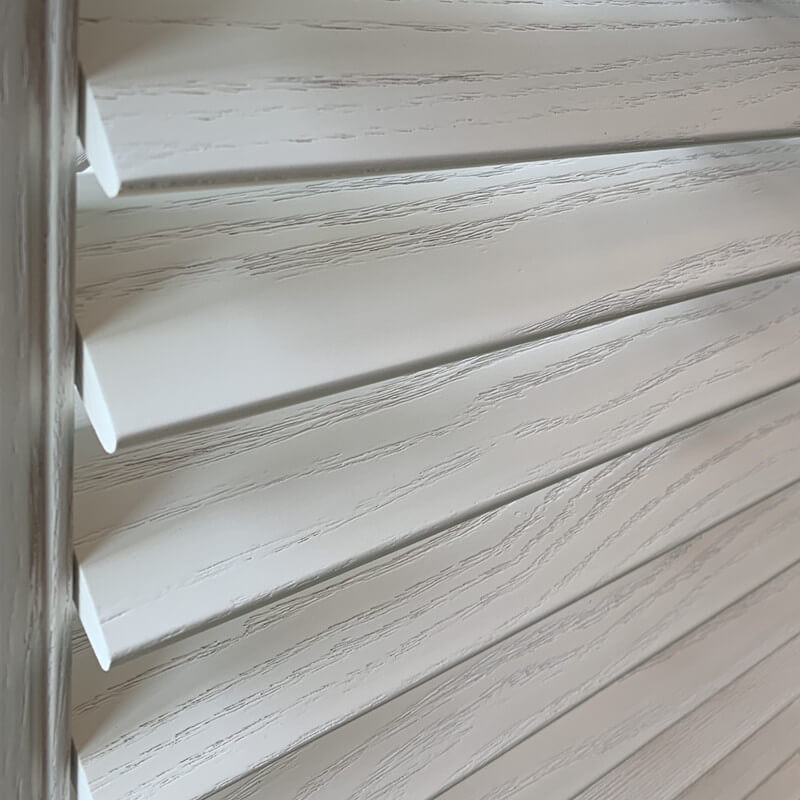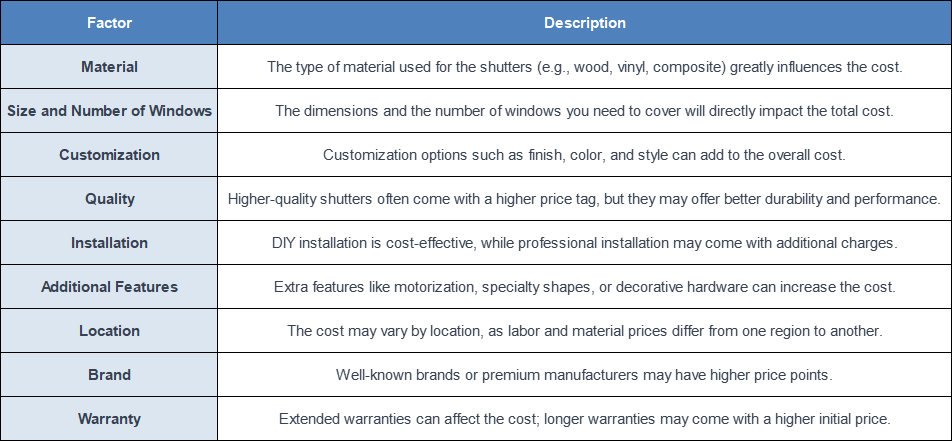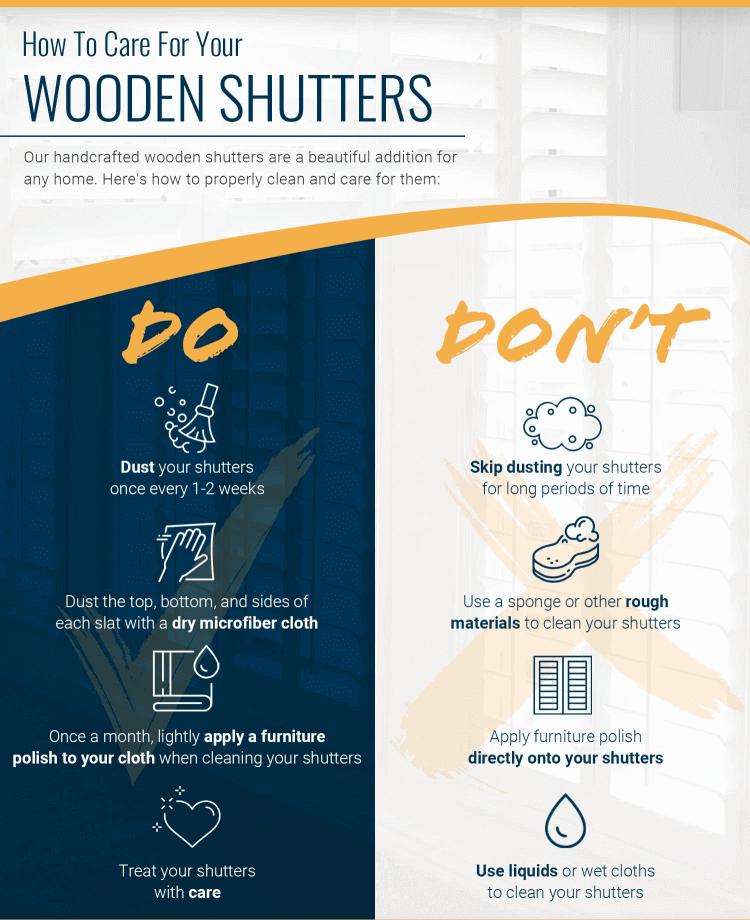Plantation shutters are one of the most popular and versatile window treatments. They can enhance the beauty, comfort, and value of your home with their timeless elegance and functionality. But how do you know which plantation shutters are right for you? What factors should you consider before buying them? In this blog article, we will provide you with the ultimate checklist for buying plantation shutters interior. We will cover everything from the types, materials, colors, sizes, and installation options of plantation shutters to the costs and maintenance tips of these shutters. By the end of this article, you will have a clear idea of what to look for and avoid when shopping for plantation shutters interior.
Types of Plantation Shutters Interior
Plantation shutters interior come in different types, depending on how they cover your windows and how they operate. Here are some of the common types of plantation shutters interior and their pros and cons:
Full Height Shutters
Full-height shutters cover the entire window from top to bottom, creating a uniform and elegant look. They are ideal for large windows, patio doors, and bay windows, providing maximum light control, privacy, and insulation. They can also be customized with a mid-rail or a divider rail, which allows you to adjust the top and bottom louvers independently. The advantages of full-height shutters are that they are simple, versatile, and cost-effective. The disadvantages are that they may block the view and make the room look smaller.

Tier-on-tier Shutters
Tier-on-tier shutters consist of two sets of shutters, one above the other, that can be opened and closed separately. They are perfect for sash windows, as they offer flexibility and functionality. You can open the top shutters to let in light and air while keeping the bottom shutters closed for privacy and security. You can also close both shutters for complete darkness and insulation. The benefits of tier-on-tier shutters are that they are adaptable, stylish, and practical. The drawbacks are that they are more expensive, heavier, and harder to install than full-height shutters.

Cafe Style Shutters
Cafe-style shutters cover only the lower half of the window, leaving the upper half open. They are suitable for street-facing windows, providing privacy and charm without blocking the natural light and the view. They are also ideal for small windows, creating an illusion of space and height. They can be paired with curtains, blinds, or valances for a more decorative and cozy look. The pros of cafe-style shutters are that they are affordable, easy to install, and attractive. The cons are that they offer less light control, insulation, and security than full-height or tier-on-tier shutters.

Solid Panel Shutters
Solid panel shutters are made of solid wood panels that cover the entire window. They are reminiscent of the traditional Victorian shutters, providing a classic and elegant look. They are great for bedrooms, as they block out the light, noise, and cold completely, creating a cozy and comfortable environment. They can also be folded back to reveal the window and let in the light and air. The advantages of solid panel shutters are that they are durable, sturdy, and insulating. The disadvantages are that they are heavy, bulky, and expensive.
How to choose the best type of plantation shutters interior for your windows and rooms? Here are some tips to help you decide:
- Consider the size, shape, and style of your windows. For example, full-height shutters work well for large and regular windows, while cafe-style shutters are more suitable for small and irregular windows.
- Consider the function and purpose of your rooms. For example, tier-on-tier shutters are more appropriate for living rooms and kitchens, where you need both light and privacy, while solid panel shutters are more fitting for bedrooms, where you need more darkness and quietness.
- Consider your personal preference and taste. For example, if you like a simple and minimalist look, you may prefer full-height shutters, while if you want a more sophisticated and ornate look, you may opt for tier-on-tier shutters.
Materials of Plantation Shutters Interior
The materials used for interior plantation shutters are significant in their appearance, durability, and cost. There are three primary materials commonly used for plantation shutters interior: wood, faux wood (composite), and vinyl (PVC). Let’s explore each material, what they are made of, and their pros and cons to help you choose the best material for your plantation shutters based on your home and budget.
Wood Plantation Shutters
Wood plantation shutters are crafted from real wood, often using high-quality hardwoods like basswood, poplar, or cedar. These materials are known for their strength and natural beauty.

Pros:
- Elegant Aesthetics: Wood shutters offer a classic and timeless look, enhancing the overall aesthetics of your interior.
- Customization: They can be easily customized to match your decor with various stains and paints.
- Durability: High-quality wood shutters are quite durable and can last for many years if properly maintained.
Cons:
- Cost: Wooden shutters tend to be more expensive compared to other materials.
- Maintenance: They may require more regular maintenance, including re-painting or staining, to keep them looking pristine.
Faux wood Plantation Shutters
Faux wood shutters are typically composed of engineered wood or MDF (Medium Density Fiberboard) wrapped in a polyvinyl (PVC) or a similar synthetic material.

Pros:
- Cost-Effective: They are more budget-friendly compared to real wood shutters.
- Moisture Resistance: Faux wood shutters are moisture-resistant, making them suitable for humid environments.
Cons:
- Heavier: Composite shutters can be heavier than wood shutters, which may affect the ease of installation.
- Customization: Limited customization options for paints and stains compared to real wood.
Vinyl/PVC Plantation Shutters
Vinyl plantation shutters are constructed entirely of polyvinyl chloride (PVC), a synthetic plastic material.

Pros:
- Affordability: Vinyl shutters are typically the most budget-friendly option.
- Durability: Vinyl shutters are highly durable, moisture-resistant, and suitable for high-humidity areas.
- Low Maintenance: They are easy to clean and require minimal maintenance.
Cons:
- Appearance: Some homeowners find that vinyl shutters may have a different aesthetic appeal than real wood shutters.
- Limited Customization: Customization options for color and finish may be more limited than wood shutters.
To choose the best material for your plantation shutter interior, consider the following factors:
- Budget: Determine how much you will spend on your shutters, significantly influencing your material choice.
- Location: Consider the environment and room where you plan to install the shutters. For high-humidity areas like bathrooms, opt for moisture-resistant materials like faux wood or vinyl.
- Aesthetics: Think about the desired look and feel of your interior. If you prefer a classic and elegant appearance, wood shutters may be the best choice. However, if budget constraints are a concern, faux wood or vinyl can provide a similar look at a more affordable price.
- Maintenance: Evaluate how much time and effort you will invest in shutter maintenance. Vinyl shutters are the easiest to maintain, while wood shutters may require more care.
By considering your budget, location, desired aesthetics, and maintenance preferences, you can choose the best material for your plantation shutters interior that suits your home and your budget.
Colors of Plantation Shutters Interior
Plantation shutters are a great way to add beauty and functionality to your windows. They come in different colors, depending on the type and the finish of the material. But how do you choose the right color for your shutters? Here are some tips to help you decide:

Think about the colors in your room.
You want your shutters to blend in or stand out from the rest of your room. If you have neutral colors, such as white, beige, cream, gray, or brown, you can choose any color for your shutters. These colors combine with any home decor and style and create a classy and elegant look. But if you want to spice up your room, you can choose more colorful or unique colors, such as blue, green, red, yellow, or black. These colors can show your personality and contrast with the rest of your room and make your shutters more noticeable.
Consider the light and heat in your room.
You want your shutters to control the amount of natural light and heat that enters your room. If you have a lot of sunlight and warmth, you can choose a light color for your shutters, such as white or cream. These colors reflect light and heat and keep your room cool and bright. But if you have little sunlight and warmth, you can choose a dark color for your shutters, such as brown or black. These colors can absorb the light and heat and keep your room warm and cozy.
Match the style and mood of your room.
You want your shutters to suit the style and mood of your room. If you have a modern and minimalist room, you can choose a neutral or monochromatic color for your shutters, such as white, gray, or black. These colors can create a sleek and simple look. But if you have a traditional and cozy room, you can choose a warm or earthy color for your shutters, such as beige, brown, or green. These colors can create a rustic and inviting look.
Sizes of Plantation Shutters Interior
Plantation shutters interior come in different sizes, depending on the dimensions of your windows and the size of the louvers. Here are some tips on how to measure and customize your shutters to fit your needs and preferences:
Measuring Your Windows
Before ordering your shutters, precise measurements are essential:
- Use a tape measure, pencil, and paper to record measurements.
- Measure the width and height of your window opening.
- Measure the depth of your window frame.
- Decide whether to mount your shutters inside or outside the window frame.
- The inside mount creates a sleek look, while the outside mount offers a dramatic and decorative appearance.
- Measure the width and height of the window frame, as well as the distance from the frame to any obstacles.
- Online resources provide detailed instructions and videos for measuring your windows accurately.

Customizing Your Shutters
After obtaining measurements, customize your shutters to match your style and preferences. This customization includes selecting:
Louver size: Louvers are the horizontal slats that control light and privacy. Their size affects appearance, functionality, and maintenance.
- 2.5-inch louvers: Ideal for small windows, offering a cozy and classic look. They provide more light control and privacy due to more slats per panel. They are affordable, easy to clean, and compatible with most window styles.
- 3.5-inch louvers: Popular for medium to large windows, creating a balanced and modern look. They offer a good amount of light control and privacy, with versatility, style, and functionality.
- 4.5-inch louvers: Perfect for large windows, creating a spacious and elegant look. They provide the best view but the least light control and privacy. They are luxurious but have a higher price tag and are heavier and harder to clean.

Consider these tips for selecting the right louver size:
- Evaluate the size and shape of your windows. Smaller or narrow windows are better suited to 2.5-inch louvers for a proportional appearance, while larger or wider windows maximize the view with 4.5-inch louvers.
- Think about the function and purpose of your rooms. Bedrooms and bathrooms benefit from smaller louvers (2.5-inch or 3.5-inch) for enhanced light control and privacy. Living rooms and kitchens, where more light is desired, can opt for larger louvers (3.5-inch or 4.5-inch), offering less privacy.
- Consider your style and preferences. If you prefer a traditional, cozy look, 2.5-inch louvers create a classic and charming ambiance. For a modern, spacious look, 4.5-inch louvers achieve a sleek and elegant appearance.
By applying these considerations, you can confidently choose the best louver size for your interior plantation shutters, ensuring they align with your room’s aesthetics, purpose, and taste.
Installation Options of Plantation Shutters Interior
Plantation shutters interior can be installed either by yourself or by a professional. Here are the pros and cons of each option and how to install your shutters correctly and safely:
Do It Yourself (DIY):
If you’re confident and skilled with DIY projects, installing your shutters can save you money and time. Here’s what you need to do:
Tools and Materials:
- Drill
- Level
- Screwdriver
- Screws
- Anchors
- Hinges
- Frames
- Manufacturer or seller’s instructions
Installation Steps:
- Attach frames to the window frame or the wall, depending on shutter type and window frame depth. Ensure frames are level and aligned with the window.
- Hang the shutters on the frames using hinges – center and balance shutters on frames.
- Adjust louver tension using tension screws for smooth, even operation.
- Attach hardware, such as the tilt rod, magnets, and catches, to the shutters and frames. Ensure the hardware is secure and functional.
Pros:
- Savings on labor costs
- Control over installation quality and timing
- Satisfaction of completing a DIY project
Cons:
- Risk of mistakes, damage, voiding warranty, or injury
Hiring a Professional
If you need help with DIY, consider hiring a professional for a hassle-free experience. Here’s how to go about it:
Steps for Hiring a Professional:
- Find a reputable installer specializing in interior plantation shutters through recommendations, online reviews, or contacts from the shutter manufacturer or seller.
- Obtain a quote from the installer detailing labor and material costs, timeframe, and warranty terms. Compare multiple quotes to make an informed decision.
- Sign a contract specifying installation details, including scope, schedule, payment terms, and liability. Ensure you understand and agree with all terms before signing.
- Schedule a convenient installation appointment, confirm the date and time, and share your contact information and address.
- Prepare your windows by removing any existing window treatments, furniture, and obstacles. Ensure windows and surroundings are clean and damage-free.
- Supervise the installation, staying present and available to monitor progress and quality. Address any questions, concerns, or communication politely and respectfully.
Pros:
- Avoid mistakes, damages, or voiding warranties
- Ensure safety and security
- Quality assurance
Cons:
- Higher labor costs
- Less control over installation timing and quality
- Potential issues or disputes with the installer
Choosing the right installation method depends on your skills, preferences, and priorities, whether a DIY project for personal satisfaction or a professional installation for peace of mind.
Costs of Plantation Shutters Interior
Interior plantation shutters are a valuable addition to your home, offering enhanced aesthetics, comfort, and property value. However, they are considered one of the more substantial investments in window treatments. Various factors come into play when determining the cost of these shutters. Here’s a simplified breakdown of these cost determinants and tips on how to make the most of your investment:

Material
The type of material used is a primary factor influencing the cost of your plantation shutters. As discussed earlier, common materials include wood, faux wood, vinyl, and composite. Costs vary based on material quality, durability, appearance, and availability. In general, wood shutters tend to be the most expensive, followed by composite, faux wood, and vinyl. Expect an average cost of $300 to $400 per window for wood shutters and $100 to $200 for vinyl shutters.
Size
The size of your shutters directly impacts the overall cost. Larger shutters require more material, labor, and hardware, increasing the price. The size of your shutters depends on your window dimensions and personal preference. You can cover the entire window or only a portion of it. Full-height shutters typically range from $250 to $350 per window, while cafe-style shutters come in at around $150 to $250.
Installation
Installation is another significant cost factor. You can install your shutters or hire a professional, depending on your skill level, budget, and available time. DIY installation can save on labor costs but may involve certain risks and challenges. Opting for a professional installation ensures quality and safety, albeit at an added cost. Expect to pay an average of $100 to $200 per window for professional installation, while DIY typically costs $50 to $100.
Maintenance
Maintenance also plays a role in the overall cost of your shutters. It includes regular cleaning, dusting, repairs, and addressing any issues or damages over time. Maintenance requirements depend on factors like the material, quality, and condition of your shutters, as well as your usage and care habits. Generally, wood shutters demand more maintenance due to their susceptibility to warping, cracking, and fading. You can spend about $50 to $100 per year, depending on the type and frequency of maintenance.
Tips for Cost Savings
To optimize your investment and reduce costs, consider the following tips:
- Compare prices from various suppliers and retailers, both online and offline. Look for discounts, coupons, sales, or promotions offering better deals.
- Negotiate with suppliers or retailers, especially when purchasing in bulk or during the off-season.
- Choose the material, size, and type of shutters that align with your home and budget without compromising quality or functionality.
- Customize your shutters to match your windows and preferences without overspending on unnecessary features.
- Follow manufacturer or seller instructions to install your shutters properly and avoid costly mistakes or damages.
- Regularly and properly maintain your shutters, following the maintenance tips provided in the next section, to prolong their lifespan and performance.
These strategies can help you manage costs while getting the most out of your investment in interior plantation shutters.
Maintenance Tips for Plantation Shutters Interior
Interior plantation shutters are not only durable but also low-maintenance, making them a great choice for your home. To keep them in top condition for years to come, here are some simple yet effective maintenance tips and solutions for common issues and damages:

Regular Cleaning:
- Cleaning your shutters at least monthly helps remove dirt, dust, and stains.
- Use a damp cloth, feather duster, or a vacuum cleaner with a soft brush attachment to gently wipe or suck up loose dust and debris.
- For stubborn stains or spills, a mixture of mild soap or detergent with water is effective. Ensure thorough rinsing and drying to avoid potential damage.
- Avoid harsh chemicals and abrasive materials to prevent harm or discoloration to your shutters.
Frequent Dusting:
- Dust your louvers weekly to prevent dust or dirt buildup that could obstruct or jam the louvers.
- Use a feather duster, soft cloth, or a vacuum cleaner with a gentle brush attachment to keep the louvers clean.
- Reach tricky corners or hidden areas with a toothbrush or cotton swab.
- Steer clear of wet or oily substances that cause your louvers to stick or warp.
Prompt Repairs:
- Address any issues or damages as soon as you notice them to maintain the functionality and appearance of your shutters.
- Loose or broken screws, hinges, or frames can be fixed with a screwdriver, hammer, or glue gun.
- Scratches, chips, or cracks can be touched with paint or stain.
- If your shutters are under warranty or guarantee, contact the manufacturer or seller for guidance or assistance.
- Delaying repairs can lead to worsened conditions and the performance of your shutters.
Prevention Measures:
- Take precautions to prevent issues or damages that may harm your shutters.
- Control indoor humidity and moisture levels using a humidifier or dehumidifier to prevent warping, cracking, or rotting.
- Shield your shutters from direct sunlight and heat using curtains, blinds, or shades to prevent fading, discoloration, or shrinkage.
- Use magnets, catches, or locks to secure your shutters during strong winds or storms to prevent banging, rattling, or breakage.
By following these maintenance tips and preventive measures, you can ensure your interior plantation shutters maintain their elegance and functionality for years.

